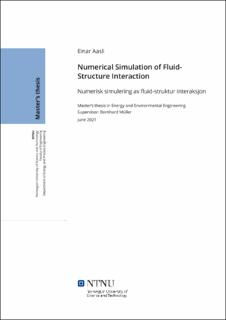| dc.contributor.advisor | Müller, Bernhard | |
| dc.contributor.author | Aasli, Einar | |
| dc.date.accessioned | 2021-10-08T17:20:45Z | |
| dc.date.available | 2021-10-08T17:20:45Z | |
| dc.date.issued | 2021 | |
| dc.identifier | no.ntnu:inspera:80323162:57753172 | |
| dc.identifier.uri | https://hdl.handle.net/11250/2788819 | |
| dc.description.abstract | I denne masteroppgaven blir en høyere ordens ghost point immersed boundary metode (GPIBM) designet for kompressibel strømning og fluid-strukturinteraksjon (fluid-structure in- teraction, FSI) applikasjoner redusert til andre orden for ̊a kunne h ̊andtere konkave geometrier. Den nye ghost point immersed boundary metoden bruker en annen ordens summation by parts (SBP) endelig differansemetode for ̊a approksimere de spatial deriverte i de kompressible Navier-Stokes-ligningene. For ̊a fjerne dispererte bølgemoder filtreres løsningen i fluiddomenet med et eksplisitt lavpassfilter av andre orden hvert n − te tids skritt. Metoden er testet p ̊a de to 2D FSI-testproblemene: en elastisk montert sylinder og en fleksibel plate bak en sylinder.
I det første problemet er en sylinder festet til en fjær og en demper plassert i et strømningsfelt ved Reynolds-tallet Re = 200, og Mach-tallet M a = 0.25. De resulterende ligningene for strukturen blir to andre ordens ordinær differensialligning (ODE) lik en harmonisk oscillator med to frihetsgrader. Drag- og lift-krefter som utøves av væsken p ̊a sylinderoverflaten inng ̊ar som eksterne krefter i ODEene. Løsningen av ODE systemet og tidsintegrasjonen i fluid løseren utføres ved hjelp av den klassiske eksplisitte fjerde ordens Runge-Kutta-metoden (RK4). Resultatene sammenlignes med resultater oppn ̊add av Yang og Stern [51], Blackburn og Karniadikis [5], og Ringstad [36] ved bruk av den opprinnelige høyere ordens GPIBM. Det gjennomføres ogs ̊a en studie av energioverføringen mellom fluidet og sylinder.
I det andre problemet er en fleksibel plate laget av et elastisk og kompressibelt materiale festet bak en sirkulær sylinder lokalisert i en 2D kanal. En forenkling av platemodellen er foretatt ved ̊a anta den er en Euler-Bernoulli bjelke begrenset til ̊a bare kunne bevege seg i lateral retning. Forskjellen i trykkraft mellom toppen og bunnen av platen som utøves av væsken, deformerer platen. Den resulterende ligningen for strukturen løses numerisk ved bruk av den implisitte Newmark-metoden, mens tidsintegrering i fluid-løseren blir foretatt ved hjelp av RK4-metoden. Simuleringer er satt opp i samsvar med FSI1 (Re = 20) og FSI2 (Re = 100) presentert i artikkelen av Turek og Hron [45]. Resultatene blir sammenlignet. Ustabiliteter som antas ̊a være for ̊arsaket av feil i oppsettet av test problemet og muligens ogs ̊a kunstige added-mass-effekter oppstår. | |
| dc.description.abstract | In this master thesis, a higher order ghost point immersed boundary method (GPIBM) designed for compressible flows and fluid-structure interaction (FSI) applications is reduced to second order to be able to deal with concave geometries. The new ghost point immersed boundary method uses a second order summation by parts (SBP) finite difference method to calculate the spatial derivatives in the compressible Navier-Stokes equations. To remove dispersed wave modes, a second order explicit low pass filter is applied to the variables solved for in the fluid domain every nth time step. The method is tested on the two 2D FSI test problems: an elastically mounted cylinder and a flexible plate behind a cylinder.
In the first problem, a cylinder attached to a spring and a damper is located in a flow field at Reynolds number Re = 200, and Mach number Ma = 0.25. The resulting governing equations of the structure thus become two second order ordinary differential equation (ODE) similar to that of a harmonic oscillator with two degrees of freedom. Drag and lift forces exerted by the fluid on the cylinder surface appear as external forces in these ODEs. The classic explicit fourth order Runge-Kutta method (RK4) is both used to solve the system of ODEs numerically, and to preform the time integration in fluid solver. Results are compared to those obtained by Yang and Stern [51], Blackburn and Karniadikis [5], and Ringstad [36] using the original higher order GPIBM. In addition, a study of the energy transfer between the fluid and cylinder is conducted.
In the second problem, a flexible plate made of an elastic and compressible material is attached behind a circular cylinder located in a 2D channel. A simplification of the plate model is preformed by assuming it is an Euler-Bernoulli beam, which displacement is restricted to the lateral direction. The difference in pressure force between the top and bottom of the plate exerted by the fluid deforms the plate. The resulting governing equation for the structure is solved numerically by the use of the implicit Newmark method, while time integration in the fluid solver is preformed using the RK4 method. Simulations are set up in accordance with those of FSI1 (Re = 20) and FSI2 (Re = 100) presented in the article by Turek and Hron [45]. Results are compared. Instabilities thought to originate from errors in the implementation of the test case and possibly artificial added mass effects occur. | |
| dc.language | eng | |
| dc.publisher | NTNU | |
| dc.title | Numerical Simulation of Fluid- Structure Interaction | |
| dc.type | Master thesis | |
